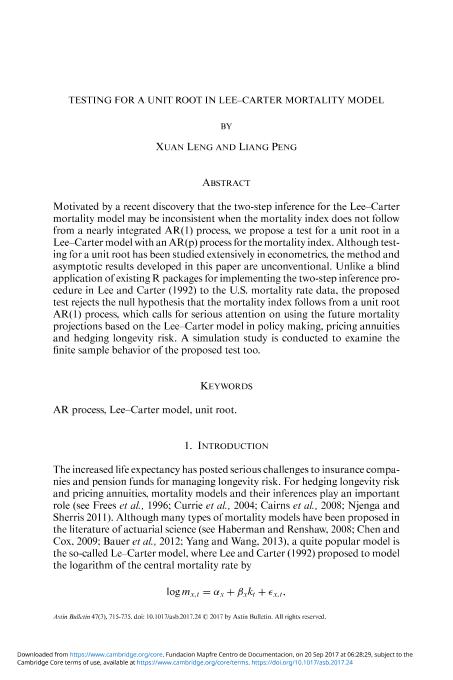Testing for a unit root in Lee-Carter mortality model

Contenido multimedia no disponible por derechos de autor o por acceso restringido. Contacte con la institución para más información.
| Tag | 1 | 2 | Valor |
|---|---|---|---|
| LDR | 00000cab a2200000 4500 | ||
| 001 | MAP20170030454 | ||
| 003 | MAP | ||
| 005 | 20170921164217.0 | ||
| 008 | 170920e20170829bel|||p |0|||b|eng d | ||
| 040 | $aMAP$bspa$dMAP | ||
| 084 | $a345 | ||
| 100 | $0MAPA20170011958$aLeng, Xuan | ||
| 245 | 1 | 0 | $aTesting for a unit root in Lee-Carter mortality model$cXuan Leng, Liang Peng |
| 300 | $a21 p. | ||
| 520 | $aMotivated by a recent discovery that the two-step inference for the LeeCarter mortality model may be inconsistent when the mortality index does not follow from a nearly integrated AR(1) process, we propose a test for a unit root in a LeeCartermodelwith an AR(p) process for themortality index. Although testing for a unit root has been studied extensively in econometrics, the method and asymptotic results developed in this paper are unconventional. Unlike a blind application of existing R packages for implementing the two-step inference procedure in Lee and Carter (1992) to the U.S. mortality rate data, the proposed test rejects the null hypothesis that the mortality index follows from a unit root AR(1) process, which calls for serious attention on using the future mortality projections based on the LeeCarter model in policy making, pricing annuities and hedging longevity risk. A simulation study is conducted to examine the finite sample behavior of the proposed test too. | ||
| 650 | 4 | $0MAPA20080555306$aMortalidad | |
| 650 | 4 | $0MAPA20080555016$aLongevidad | |
| 650 | 4 | $0MAPA20080544249$aÍndices | |
| 650 | 4 | $0MAPA20080592011$aModelos actuariales | |
| 650 | 4 | $0MAPA20080586454$aModelos analíticos | |
| 700 | $0MAPA20080653569$aPeng, Liang | ||
| 773 | 0 | $wMAP20077000420$tAstin bulletin$dBelgium : ASTIN and AFIR Sections of the International Actuarial Association$x0515-0361$g01/09/2017 Volumen 47 Número 3 - septiembre 2017 , p. 715-735 |

